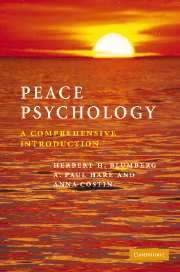Book contents
- Frontmatter
- Contents
- Preface
- Acknowledgements
- The scope, structure and content of this book
- Part I Introduction
- Part II Interdisciplinary practice
- Part III Primary psychological topics
- 6 Developmental issues: children and adolescents
- 7 Theory and practice related to primary psychological topics: attitudes, psychodynamics, cognition and images, and aggression
- 8 Language and communication
- Part IV Core topics in peace and environmental studies
- Part V Terrorism
- References
- Index
8 - Language and communication
Published online by Cambridge University Press: 05 June 2012
- Frontmatter
- Contents
- Preface
- Acknowledgements
- The scope, structure and content of this book
- Part I Introduction
- Part II Interdisciplinary practice
- Part III Primary psychological topics
- 6 Developmental issues: children and adolescents
- 7 Theory and practice related to primary psychological topics: attitudes, psychodynamics, cognition and images, and aggression
- 8 Language and communication
- Part IV Core topics in peace and environmental studies
- Part V Terrorism
- References
- Index
Summary
Studies of communication seem to touch on many, perhaps most, of the areas of peace psychology – particularly as regards interdisciplinary matters and primary psychological topics. Language characteristics impact on intragovernmental and especially intercultural and international relations, on the framing of peace education, on the diction of feminist approaches and on how wars are ‘sold’ to the public. The ascribed meaning of concepts such as war and peace may inform our understanding of socialization and of adults' attitudes in particular cultures. Rhetoric may reveal the psychodynamic properties of perceptions of (say) weaponry. Accordingly the present chapter has an organization that is rather similar to that of this book as a whole.
In volumes cross-cutting the aforementioned topics, Korzenny and Ting-Toomey (1990; Ting-Toomey and Korzenny, 1991) collected a variety of theoretical and applied studies relating to cross-cultural contrasts of interpersonal communication and (among other things) conflict resolution. Theories of communication for peace need to take account of the special nature of various forms of discourse, for example: (a) the language of diplomacy – which is highly salient to all parties and must be tactful – in partial contrast to less formal ‘track two’ diplomacy in which parties' real needs may be shared (see discussion of Kelman's work described in chapter 14, below); (b) the need, in general, for not only power but also trust to be implicit in diplomacy discourse at all levels; and (c) the need for communication to overcome various ‘hurdles’ in people's information-processing paradigms if change (such as reversing malignant spirals of hostility) is to be effected.
- Type
- Chapter
- Information
- Peace PsychologyA Comprehensive Introduction, pp. 88 - 94Publisher: Cambridge University PressPrint publication year: 2006
- 1
- Cited by

